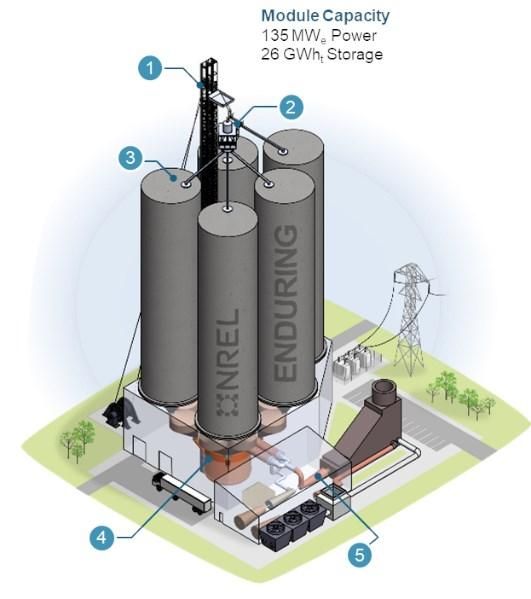Optimizing Lithium-Ion Batteries with Machine Learning Insights – Bioengineer.org

Report on Multi-Objective Optimization of Lithium-Ion Batteries and Alignment with Sustainable Development Goals
Introduction to the Research
- A study by Ju, Li, and Luo utilizes machine learning surrogate models for the multi-objective optimization of Lithium-Ion Battery (LIB) design.
- The primary objective is to resolve the conflict between maximizing energy density and minimizing capacity loss over the battery’s lifecycle.
- This technological advancement is pivotal for developing next-generation energy storage solutions that are essential for achieving global sustainability targets.
Key Methodological Innovations
- The research employs advanced algorithms to simulate and predict material behaviors, moving beyond traditional trial-and-error development methods.
- It establishes a ‘Pareto front’ to identify optimal design configurations where improvements in one objective do not necessitate sacrifices in the other.
- This data-driven paradigm accelerates research and development, reduces costs, and informs early-stage design decisions for enhanced efficiency and sustainability.
Alignment with United Nations Sustainable Development Goals (SDGs)
SDG 7: Affordable and Clean Energy
- Enhanced LIBs are critical for the effective storage of intermittent renewable energy sources, such as solar and wind, thereby improving grid stability and making clean energy more reliable.
- By increasing energy density and longevity, the research contributes to making clean energy storage more economically viable and accessible on a global scale.
SDG 9: Industry, Innovation, and Infrastructure
- The study represents a significant technological innovation, fostering a paradigm shift in battery development from empirical methods to data-driven optimization.
- It promotes sustainable industrialization by providing manufacturers in the automotive and consumer electronics sectors with a methodology to produce more efficient and durable products, enhancing their competitive advantage.
SDG 11: Sustainable Cities and Communities
- The optimization of LIBs is fundamental to advancing the electric vehicle (EV) market.
- Batteries with higher energy density and longer lifespans directly translate to EVs with extended range and greater reliability, encouraging a transition to sustainable urban transport and reducing urban air pollution.
SDG 12: Responsible Consumption and Production
- Minimizing capacity loss extends the operational lifetime of batteries, which promotes more sustainable consumption patterns by reducing the frequency of replacement.
- This leads to a significant reduction in electronic waste and lessens the environmental and social impact associated with the extraction of raw materials for new battery production.
SDG 13: Climate Action
- By facilitating the large-scale integration of renewable energy and the widespread adoption of EVs, this research directly supports the reduction of greenhouse gas emissions.
- Efficient and durable energy storage is a cornerstone technology for mitigating climate change and enabling the transition to a low-carbon global economy.
Industrial Implications and Future Directions
Pathway to Commercialization and Impact
- Validation of the machine learning models through extensive real-world testing is crucial to ensure reliability and performance in commercial applications.
- Strategic collaboration between researchers and battery manufacturers is necessary to integrate these insights into industrial design and manufacturing processes effectively.
- Developing industry-standard protocols based on this machine learning approach can accelerate innovation across the entire energy storage sector.
Future Research and Long-Term Sustainability
- Future research is expected to explore alternative, more sustainable, and abundant materials for battery production, further reducing environmental impact.
- The continued application of machine learning can optimize hybrid energy systems, yielding even greater leaps in performance and efficiency.
- The ultimate goal is a future where energy storage solutions are not only powerful and efficient but also integral to a circular economy, supporting sustainable development for generations to come.
Analysis of Sustainable Development Goals in the Article
1. Which SDGs are addressed or connected to the issues highlighted in the article?
-
SDG 7: Affordable and Clean Energy
The article directly connects the research on improved lithium-ion batteries to the broader goal of a sustainable energy landscape. It states, “Effective battery technologies are vital for integrating renewable energy sources such as solar and wind into the global energy grid,” which is central to achieving clean energy for all.
-
SDG 9: Industry, Innovation, and Infrastructure
The core of the article discusses a technological innovation—using machine learning to optimize battery design. It highlights how this innovation can lead to “an accelerated time to market for improved battery designs, reduced R&D costs,” and a “competitive advantage for manufacturers.” The emphasis on research, development, and industry collaboration (“partnerships with industry players”) aligns perfectly with this goal.
-
SDG 11: Sustainable Cities and Communities
The article explicitly mentions the application of this technology in electric vehicles (EVs). It notes that “As electric vehicles become increasingly popular, the need for batteries that can provide extended range and increased longevity has never been more pressing.” Better batteries are a key component for developing sustainable transport systems, which is a crucial aspect of sustainable cities.
-
SDG 12: Responsible Consumption and Production
By focusing on “minimizing capacity loss” and creating batteries that “maintain their performance over longer lifetimes,” the research contributes to more durable products. This reduces the frequency of battery replacement, thereby decreasing waste and promoting more sustainable consumption patterns.
-
SDG 13: Climate Action
The transition to renewable energy and the widespread adoption of electric vehicles are critical strategies for combating climate change. The article positions the research as playing a “pivotal role in the broader narrative of achieving sustainability” by making “electric storage options more viable and efficient,” thus facilitating the shift away from fossil fuels.
2. What specific targets under those SDGs can be identified based on the article’s content?
-
SDG 7: Affordable and Clean Energy
- Target 7.2: By 2030, increase substantially the share of renewable energy in the global energy mix. The article supports this by describing how improved energy storage is “vital for integrating renewable energy sources such as solar and wind.”
- Target 7.a: By 2030, enhance international cooperation to facilitate access to clean energy research and technology… and promote investment in energy infrastructure and clean energy technology. The research itself represents an advancement in clean energy technology that can accelerate this transition.
-
SDG 9: Industry, Innovation, and Infrastructure
- Target 9.4: By 2030, upgrade infrastructure and retrofit industries to make them sustainable, with increased resource-use efficiency and greater adoption of clean and environmentally sound technologies. The development of more efficient and longer-lasting batteries is a clean technology that industries from automotive to consumer electronics can adopt.
- Target 9.5: Enhance scientific research, upgrade the technological capabilities of industrial sectors… encouraging innovation. The article is a clear example of enhancing scientific research through machine learning to drive technological advancements in the battery industry.
-
SDG 11: Sustainable Cities and Communities
- Target 11.2: By 2030, provide access to safe, affordable, accessible and sustainable transport systems for all. The research aims to improve batteries for electric vehicles, which is fundamental to making sustainable transport more viable and widespread.
-
SDG 12: Responsible Consumption and Production
- Target 12.5: By 2030, substantially reduce waste generation through prevention, reduction, recycling and reuse. By creating batteries with minimized capacity loss and longer lifetimes, the technology directly contributes to waste reduction through prevention and reduced consumption of new batteries.
-
SDG 13: Climate Action
- Target 13.2: Integrate climate change measures into national policies, strategies and planning. The technologies discussed in the article, which support renewable energy and electric vehicles, are key components of climate action strategies worldwide.
3. Are there any indicators mentioned or implied in the article that can be used to measure progress towards the identified targets?
-
Explicit Indicators:
The article explicitly mentions key performance metrics that the research aims to optimize. These can serve as direct indicators of technological progress.
- Energy Density: Defined as “the amount of energy stored per unit mass,” this is a primary objective of the optimization process. An increase in energy density would be a clear measure of progress.
- Capacity Loss / Longevity: The goal of “minimizing capacity loss over repeated charging cycles” is a central theme. Measuring the rate of capacity fade or the number of charge cycles before significant degradation occurs would be a direct indicator of success.
- R&D Costs and Time to Market: The article suggests that the machine learning approach leads to “an accelerated time to market for improved battery designs, reduced R&D costs.” These are measurable economic indicators of innovation efficiency.
-
Implied Indicators:
The article implies broader, systemic indicators that would measure the real-world impact of this technology.
- Share of Renewable Energy in the Grid: The article states that better batteries are “vital for integrating renewable energy.” Therefore, an increase in the percentage of energy generated from solar and wind would be an indirect indicator of the successful deployment of such storage technologies.
- Adoption Rate of Electric Vehicles (EVs): The research is motivated by the needs of the EV market. An increase in the market share of EVs could be partly attributed to improvements in battery range and longevity, which this research addresses.
- Reduction in Battery Waste: By creating longer-lasting batteries, the technology aims to reduce the need for replacements. A decrease in the volume of discarded lithium-ion batteries would be an indicator of progress towards responsible consumption.
4. Summary Table of SDGs, Targets, and Indicators
| SDGs | Targets | Indicators |
|---|---|---|
| SDG 7: Affordable and Clean Energy |
|
|
| SDG 9: Industry, Innovation, and Infrastructure |
|
|
| SDG 11: Sustainable Cities and Communities |
|
|
| SDG 12: Responsible Consumption and Production |
|
|
| SDG 13: Climate Action |
|
|
Source: bioengineer.org
What is Your Reaction?
 Like
0
Like
0
 Dislike
0
Dislike
0
 Love
0
Love
0
 Funny
0
Funny
0
 Angry
0
Angry
0
 Sad
0
Sad
0
 Wow
0
Wow
0
















































:focal(1500,1000)/https://media.globalcitizen.org/a6/9a/a69a4720-d8a1-4715-b596-18738d03c05c/rotary_polio_hero_image.jpg?#)







/countries/sri-lanka/photo-credit---dmc-sri-lanka.tmb-1200v.jpg?sfvrsn=dc298bcc_1#)




















